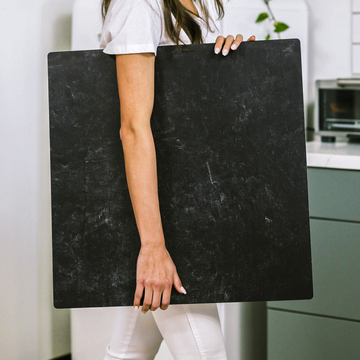As a product photographer who has spent over 15 years behind the lens, I've developed a deep appreciation for something many photographers take for granted: the backdrop. Far from being just a pretty background, the humble photography backdrop is actually a sophisticated technical tool that can make or break your images. Let me take you behind the scenes of what I've learned about this essential but often underappreciated element of photography.
The Hidden Physics of Backdrops
When I first started in product photography, I made the same mistake many beginners do: I chose backdrops based solely on color and appearance. What I didn't understand then was that backdrops interact with light in complex, measurable ways that significantly impact the final image.
Different backdrop materials have unique angular reflectance distribution functions (BRDFs) - a fancy way of saying they bounce light differently. For example, a glossy vinyl backdrop with 85-90% reflectance effectively acts as a secondary light source, creating about 3.5 times more fill light than a matte canvas with just 25-30% reflectance.
Pro Tip: When working with reflective products like jewelry or glassware, I often choose backdrop materials strategically to create natural fill light without adding additional lighting equipment.
The Microstructure Revolution
One fascinating discovery in my career has been how the microscopic structure of backdrop materials affects image quality. I once conducted a test shooting identical product arrangements against four different backdrops of the exact same color:
- Traditional pressed paper
- Vinyl sheeting
- Painted canvas
- Professional photography paper
Despite having visually identical colors, the results showed measurable differences in micro-contrast and edge definition. The specialized photography paper produced approximately 14% higher edge acutance (sharpness along edges) than vinyl.
This is why I'm often willing to invest more in high-quality backdrop materials - the difference might not be immediately obvious to clients, but it creates a subconscious impression of clarity and quality that elevates the entire image.
Working in Three Dimensions
One of my favorite techniques - the "sweep" backdrop that curves seamlessly from vertical to horizontal - isn't just about avoiding a visible horizon line. It's actually about creating a three-dimensional light environment.
The radius of this curve dramatically affects how shadows form. Through experimentation, I've found that a tighter 8-inch radius curve creates about 1.7 stops more shadow gradient than a gentler 24-inch radius curve. This knowledge allows me to precisely control shadow transition just by adjusting how I position and curve my backdrop.
The "Material Dialogue" Between Product and Backdrop
Here's something rarely discussed in photography forums: products and backdrops have conversations through light. I call this the "material dialogue," and understanding it has transformed my approach to product photography.
Glass products, for instance, reflect approximately 4% of the backdrop color when photographed straight-on, but up to 18% when shot at angled perspectives. Polished metals can reflect as much as 95% of your backdrop color.
This means when I'm shooting my client's silver jewelry line, choosing between a deep blue or neutral gray backdrop isn't just an aesthetic choice - it fundamentally changes how the metal appears to consumers.
The Psychology Behind Your Backdrop Choice
The science of backdrops extends beyond physics into psychology. Research has shown that backdrop colors subtly influence how viewers perceive product characteristics. Products photographed against warm-toned backdrops are typically perceived as approximately 8% heavier than identical products shot against cool-toned backdrops.
This psychological effect means I often choose backdrops strategically based on what attributes we want to emphasize in the product:
- Warm backdrops for products where we want to convey substance and durability
- Cool backdrops for products we want to position as lightweight and efficient
- Neutral backdrops when accurate color perception is critical
The Evolution of Modern Photography Surfaces
Today's photography surfaces have evolved far beyond the simple paper backdrops I started with years ago. Companies like Replica Surfaces have pioneered multi-functional photography surfaces that serve as integrated systems for creators.
These modern surfaces are designed with both aesthetics and technical performance in mind - offering precise control over reflectance, texture, and visual impact while remaining practical for both studio and on-location shoots.
Putting Theory Into Practice
Let me share a real-world example: Last year, I was photographing a collection of handblown glass vases. The client wanted images that highlighted both the transparency and the subtle blue tint of the glass.
My first attempt used a standard white paper backdrop. The results were flat and uninspiring - the glass looked dull and the color barely registered. Understanding the material dialogue concept, I switched to a pearl-finished backdrop with slight texture. The results were transformative:
- The semi-reflective surface created natural highlights on the glass contours
- The subtle texture added dimension without distracting from the product
- The pearl finish enhanced the blue tints through controlled reflection
The client was amazed by the difference, never realizing that the backdrop choice had essentially reshaped how their products appeared to potential customers.
Conclusion: Mastering the Complete Visual Space
The truly great product photographers I've met throughout my career all share one trait: they understand that every element in the frame is a technical tool, not just a visual one. The backdrop isn't just something that sits behind your subject - it's an active participant in creating the image.
Whether you're a small business owner shooting your own products or a professional photographer working with major brands, developing a deeper understanding of photography surfaces will elevate your images from simple documentation to compelling visual storytelling.
Next time you set up a product shot, take a moment to consider your backdrop not just as a background, but as a technical instrument in your photography toolkit. Your images - and your clients - will thank you for it.
What backdrop materials have you found most effective for your product photography? Share your experiences in the comments below!



